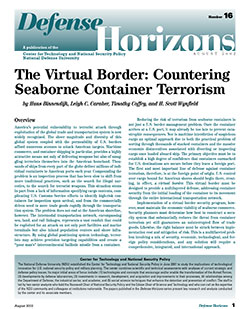Overview
 America’s potential vulnerability to terrorist attack through exploitation of the global trade and transportation system is now widely recognized. The sheer magnitude and diversity of this global system coupled with the permeability of U.S. borders afford numerous avenues to attack American targets. Maritime commerce, and container shipping in particular, provides a highly attractive means not only of delivering weapons but also of smuggling terrorists themselves into the American homeland. Thousands of ships from every part of the globe deliver millions of individual containers to American ports each year. Compounding the problem is an inspection process that has been slow to shift from more traditional practices, such as the search for illegal narcotics, to the search for terrorist weapons. This situation stems in part from a lack of information specifying cargo contents, complicating U.S. Customs Service efforts to identify high-risk containers for inspection upon arrival, and from the commercially driven need to move trade goods rapidly through the transportation system. The problem does not end at the American shoreline, however. The intermodal transportation network, encompassing sea, land, and rail linkages, represents a vast conduit that could be exploited for an attack on not only port facilities and marine terminals but also inland population centers and shore infrastructure. By using global positioning system technology, terrorists may achieve precision targeting capabilities and create a “poor man’s” intercontinental ballistic missile from a container.
America’s potential vulnerability to terrorist attack through exploitation of the global trade and transportation system is now widely recognized. The sheer magnitude and diversity of this global system coupled with the permeability of U.S. borders afford numerous avenues to attack American targets. Maritime commerce, and container shipping in particular, provides a highly attractive means not only of delivering weapons but also of smuggling terrorists themselves into the American homeland. Thousands of ships from every part of the globe deliver millions of individual containers to American ports each year. Compounding the problem is an inspection process that has been slow to shift from more traditional practices, such as the search for illegal narcotics, to the search for terrorist weapons. This situation stems in part from a lack of information specifying cargo contents, complicating U.S. Customs Service efforts to identify high-risk containers for inspection upon arrival, and from the commercially driven need to move trade goods rapidly through the transportation system. The problem does not end at the American shoreline, however. The intermodal transportation network, encompassing sea, land, and rail linkages, represents a vast conduit that could be exploited for an attack on not only port facilities and marine terminals but also inland population centers and shore infrastructure. By using global positioning system technology, terrorists may achieve precision targeting capabilities and create a “poor man’s” intercontinental ballistic missile from a container.
Reducing the risk of terrorism from seaborne containers is not just a U.S. border management problem. Once the container arrives at a U.S. port, it may already be too late to prevent catastrophic consequences. Nor is maritime interdiction of suspicious cargo an optimal approach due to both the practical problem of sorting through thousands of stacked containers and the massive economic disincentives associated with diverting or inspecting cargo once loaded aboard ship. The primary objective must be to establish a high degree of confidence that containers earmarked for U.S. destinations are secure before they leave a foreign port. The first and most important line of defense against container terrorism, therefore, is at the foreign point of origin. U.S. control over cargo bound for American shores should begin there, creating, in effect, a virtual border. This virtual border must be designed to provide a multilayered defense, addressing container security from the initial loading of the container to its movement through the entire international transportation network.
Implementation of a virtual border security program, however, must maintain the economic viability of seaborne commerce. Security planners must determine how best to construct a security system that substantially reduces the threat from container terrorism yet still guarantees an uninterrupted flow of trade goods. Likewise, the right balance must be struck between implementation cost and mitigation of risk. This is a multifaceted problem involving a mix of security, economic, technological, and foreign policy considerations, and any solution will require a comprehensive, integrated, and international approach.
READ MORE >>